Becoming a fossil: From the birth of the organism to discovery by a paleontologist, fossils go through four general stages.
 Biotic stage: Birth to death. The organism grows whatever tissue is capable of being preserved then dies. It has done its part. Whether it will become part of the fossil record depends on whether its carcass can remain intact long enough to be buried. The quicker the better because.....
Biotic stage: Birth to death. The organism grows whatever tissue is capable of being preserved then dies. It has done its part. Whether it will become part of the fossil record depends on whether its carcass can remain intact long enough to be buried. The quicker the better because.....
 Interment stage: Death to final burial. The carcass is exposed to:
Interment stage: Death to final burial. The carcass is exposed to:
- Decomposition: destruction of soft tissues (mostly by bacteria)
- Disassociation: hard parts become separated
- Abrasion: surface details of hard parts lost
- Breakage: hard parts degraded into fragments
- Winnowing: fragments sorted by size due to moving water
 Diagenetic stage: Final burial to discovery. Once buried, the remains are officially fossils, however their existence is still perilous. Diagenesis results in:
Diagenetic stage: Final burial to discovery. Once buried, the remains are officially fossils, however their existence is still perilous. Diagenesis results in:
- Dissolution: hard parts chemically altered into soluble substances
- Compaction: remains crushed by overlying sediment
- Recrystallization: ground water & minerals enter, form crystals & disrupt remains
 Investigative stage: Discovery to ultimate destruction. Every day, fossils are unearthed by erosion, only quickly to be destroyed by it. To enter the fossil record, as scholars understand it, a fossil must be exhumed (usually by natural processes), discovered, and described.
Investigative stage: Discovery to ultimate destruction. Every day, fossils are unearthed by erosion, only quickly to be destroyed by it. To enter the fossil record, as scholars understand it, a fossil must be exhumed (usually by natural processes), discovered, and described.
Not all clades of organisms produce preservable hard parts. Soft bodied organisms CAN produce fossils under special (konservat-lagersätten) situations to be considered later.
The compositional roster of these skeletons is non-random. Main hard substances found in organisms:

Calcareous skeletons are thought to have originated at least twenty times in eukaryote evolution. Also the first biomineral skeletons known, dating to 750 m.a. Typically secreted extracellularly. The abundance of independent origins suggests the exaptation (coopting) of an underlying biochemical mechanism present in soft-bodied precursors such as:
- Biochemistry for transport of Ca2+ ions.
- Biochemistry for prevention of "accidental" external calcification, a danger in times of high CaCO3 saturation.

- Silica - SiO2 (mostly in the form of cryptocrystalline quartz or Opal - hydrated silica - SiO2 - nH2O ). Less widely distributed, with at least eight independent origins. Silica and opal are secreted intracellularly, in vesicles possibly derived from golgi bodies. Thus almost all silica secreting organisms are unicellular.
- Calcium phosphates such as apatite - Ca5(PO4)3
In stark contrast to silica, appears exclusively in animals, mostly brachiopods (left) and vertebrates. Not surprising since PO3 ion is a relatively scarce nutrient that one might prefer not to "waste" on skeleton construction. Accordingly, vertebrates, who make the most extensive use, have skeletons that are constantly being remodeled by resorbtion, allowing the metabolism frequent access to the PO3. The biochemistry of phosphate precipitation seems to be linked with that of calcium carbonate. Indeed, carbonate substrates have been used surgically as bases for bone regeneration.

- Complex organic molecules forming the framework for robust soft tissues: While not exactly "hard parts" some soft tissues have reasonably good fossilization potentials. These include:
- Chitin (a sugar) - the basis of arthropod cuticle.
- Cellulose (a sugar) - the foundation of vascular plant skeletons
- Spongin (a protein) - the basis of the structural tissue of most sponges
List of some of the major clades producing common body fossils: (Classifications used here largerly follow these on the UMCP website)
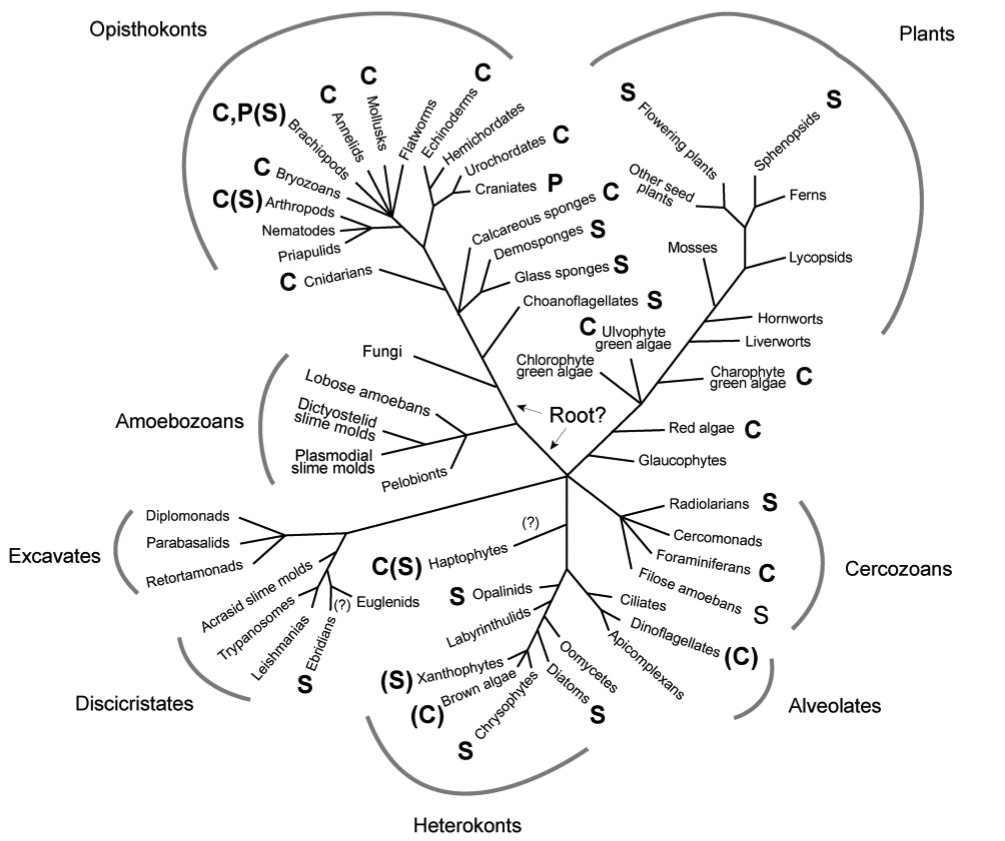
Phylogeny of skeleton-forming eukaryotes from Knoll, 2003.
Organisms with silicious skeletons
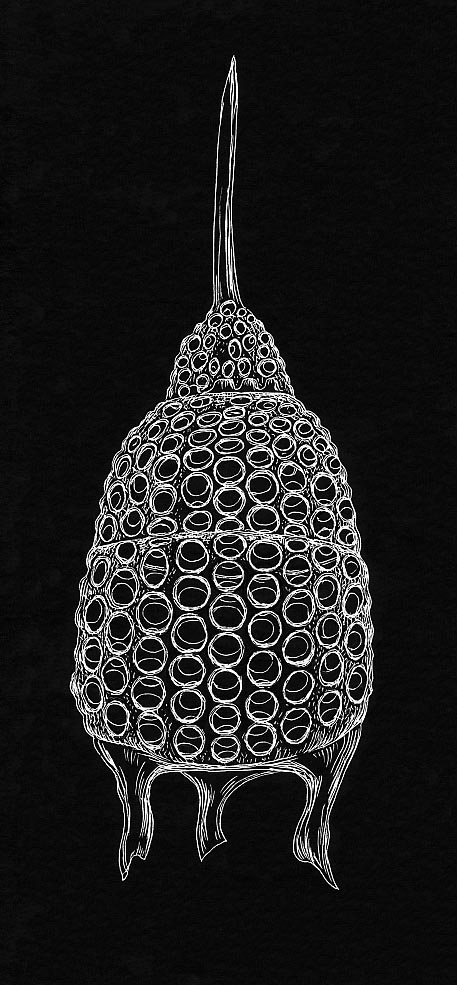 Radiolaria: (Cambrian - rec.)
Radiolaria: (Cambrian - rec.)
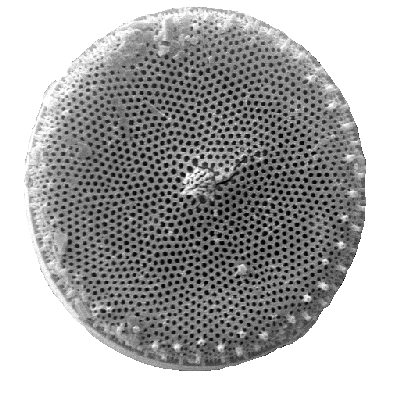
- Planktonic, microscopic
- Shells are two-pieced frustules (like little pillboxes), made of opal
- Accumulations produce sediment called diatomaceous earth
- Biostratigraphically significant? - Yes
- Volumetrically significant? - No
- Significant binder of sediment? - No
Organisms with calcareous skeletons
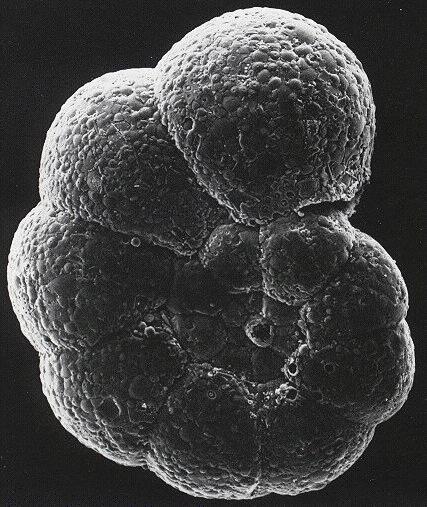
- Include benthic and (derived) planktonic forms
- Barely macroscopic (must use microscope to see details)
- Basal members with agglutinated skeletons, more derived with calcareous tests
- Extraordinarily abundant in marine record
- Biostratigraphically significant? - Yes
- Volumetrically significant? - No
- Significant binder of sediment? - No
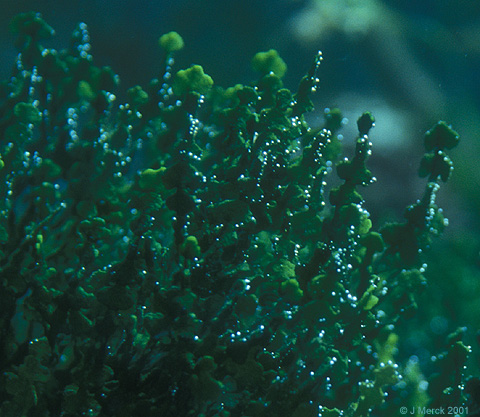 Chlorophyta green algae:
Chlorophyta green algae:
- Dasycladales: (Ediacaran - rec.) Include
- Receptaculitids, (Cambrian - Permian) a strictly Paleozoic group of dasyclades and important reef former
- Living macroscopic unicellular taxa such as Acetabularia.
- Biostratigraphically significant? - No
- Volumetrically significant? - No
- Significant binder of sediment? - No
- "Calcareous algae:" Taxonomically diverse array with calcareous skeletons.
Dead
- Benthic marine green algae with skeleton of calcite or aragonite
- Broken down dasyclade skeletal fragments are a major component of limestones
- Biostratigraphically significant? - No
- Volumetrically significant? - Yes
- Significant binder of sediment? - Yes
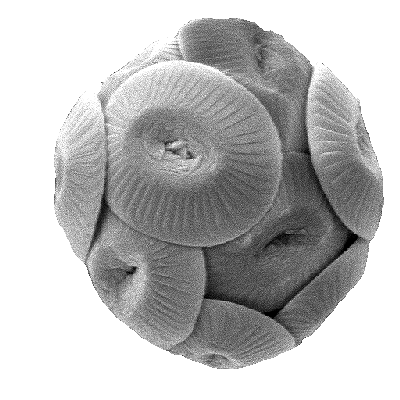
- Planktonic, extraordinarily small forms
- Skeleton comprised of many individual clacareous plates called coccoliths
- Accumulations of coccoliths form the rock chalk. Thus
- Biostratigraphically significant? - Yes
- Volumetrically significant? - Yes
- Significant binder of sediment? - No
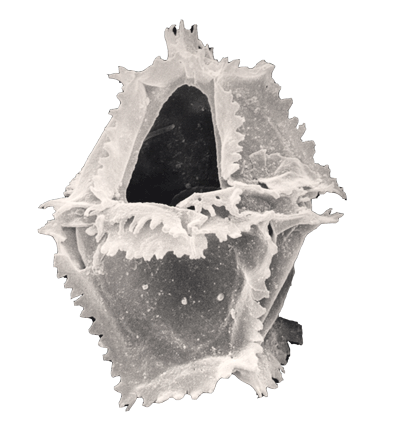
- Planktonic, some parasitic (including zooxanthellae)
- Microscopic
- Normal test is cellulose; have a calcareous cyst stage
- Biostratigraphically significant? - Yes
- Volumetrically significant? - No
- Significant binder of sediment? - No
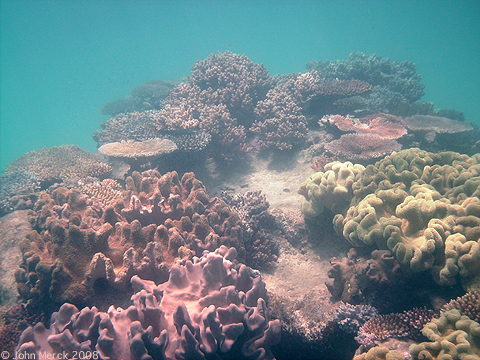 Cnidaria (corals)(Ediacaran - rec.) Most cnidarians, including jellyfish, hydras, etc, have no hard parts. Those that do are termed "corals" although this groups has evolved hard tissues several times.
Cnidaria (corals)(Ediacaran - rec.) Most cnidarians, including jellyfish, hydras, etc, have no hard parts. Those that do are termed "corals" although this groups has evolved hard tissues several times.
- Benthic epifaunal sessile suspension feeders
- Majority of cnidarians are not coralline
- Biostratigraphically significant? - Yes
- Volumetrically significant? - Sometimes
- Significant binder of sediment? - Yes
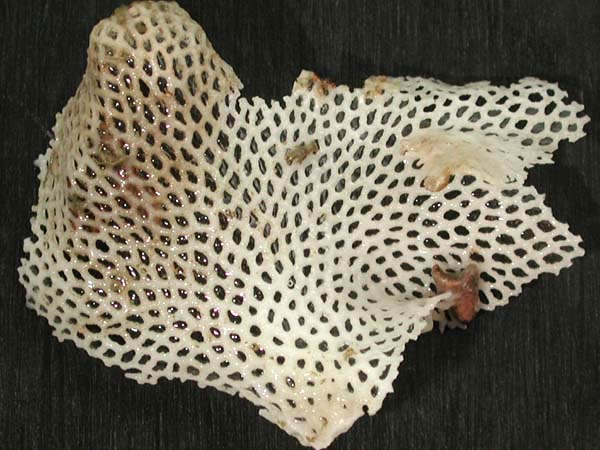 Bryozoa: (Ordovician - rec.)
Bryozoa: (Ordovician - rec.)
- Exclusively colonial, benthic, epifaunal, sessile suspension feeders
- Some forms lack hard skeleton; those that have them are calcareous
- Minor components of many reef systems
- Biostratigraphically significant? - Yes
- Volumetrically significant? - No
- Significant binder of sediment? - Yes
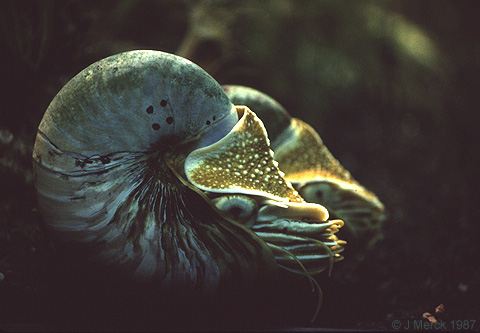 Mollusca: (Cambrian - rec.)
Mollusca: (Cambrian - rec.)
- Extremely significant, extremely diverse clade of (almost all motile) animals
- Most forms have shells (single, double, or eight) made of aragonite (i.e. calcareous)
- Biostratigraphically significant? - Yes
- Volumetrically significant? - Sometimes
- Significant binder of sediment? - No
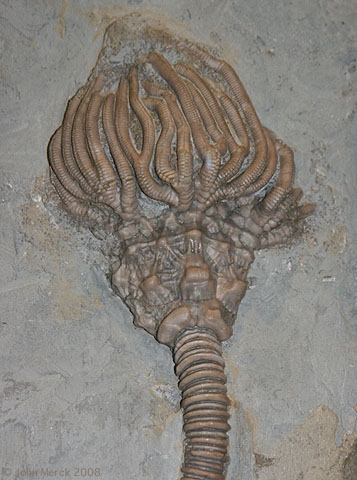 Echinodermata: (Ediacaran - rec.)
Echinodermata: (Ediacaran - rec.)
- Displays stereom, complex calcitic skeletal tissue in which each element is a single calcite crystal, permeated with perforations.
- Strictly marine, macroscopic, almost all epifaunal
- Biostratigraphically significant? - Yes
- Volumetrically significant? - Yes
- Significant binder of sediment? - No
Organisms with phosphatic skeletons
 Vertebrata and relatives: (Cambrian - rec.)
Vertebrata and relatives: (Cambrian - rec.)
- Basalmost forms have few hard parts
- Primitive forms have exoskeleton of bone, endoskeleton of cartilage
- Derived forms ossify the endoskeleton and reduce the exoskeleton
- Complex skeletons
- Other hard tissues include enamel. and dentine - originally found in both teeth and dermal armor
- Biostratigraphically significant? - Yes
- Volumetrically significant? - No
- Significant binder of sediment? - No
Organisms with diverse skeletal materials
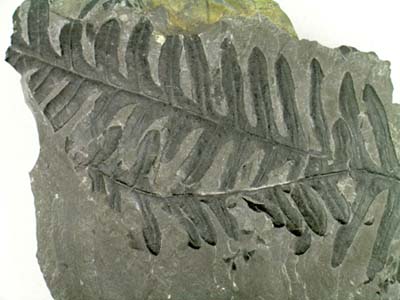
- True plants: terrestrial (or secondarily aquatic) multicellular chlorophytes
- Hard parts (including wood, stems, leaves, spores, pollen, seeds, fruit, flowers, depending on the clade) are cellulose
- Form coal under certain circumstances - volumetrically significant part of rock record and economically significant.
- Seed-plant pollen is extremely important as index fossils
- Biostratigraphically significant? - Yes
- Volumetrically significant? - Yes
- Significant binder of sediment? - Yes
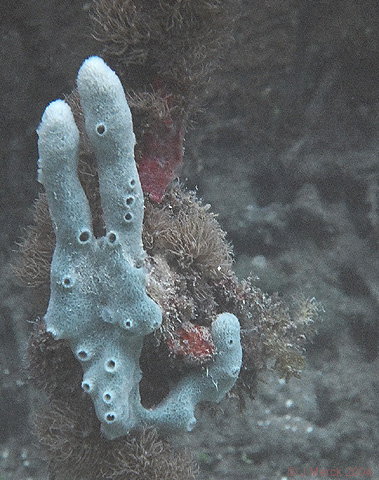 Porifera (sponges): (Cambrian - rec.)
Porifera (sponges): (Cambrian - rec.)
- Hard parts include calcareous, siliceous, and spongin spicules
- Spongin doesn't fossilize readily. Various important fossil clades of sponges are all calcareous except for hexactinellids).
- Biostratigraphically significant? - Sometimes
- Volumetrically significant? - Yes
- Significant binder of sediment? - Yes
 Brachiopoda: (Cambrian - rec.)
Brachiopoda: (Cambrian - rec.)
- Solitary benthic suspension feeders, strictly marine
- Two hard valves surrounding most body tissue
- Hard parts are calcium phosphates in lingulates, calcite in craniids and articulates
- Phenomenal fossil record; modern diversity much lower than Paleozoic diversity
- Biostratigraphically significant? - Yes
- Volumetrically significant? - No
- Significant binder of sediment? - No
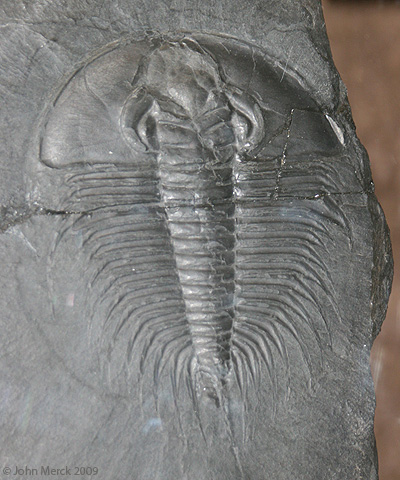 Arthropoda: (Cambrian - rec.)
Arthropoda: (Cambrian - rec.)
- Extremely common, diverse clade of (predominantly) motile animals
- Grow by ecydysis, so a single individual produces many potential fossils
- Majority have exoskeleton of chitin and mediocre fossil records
- Trilobites (right) calcified their skeletons, giving them an excelent record.
- Biostratigraphically significant? - Yes
- Volumetrically significant? - No
- Significant binder of sediment? - No
To Syllabus.
Last modified: September 3, 2010